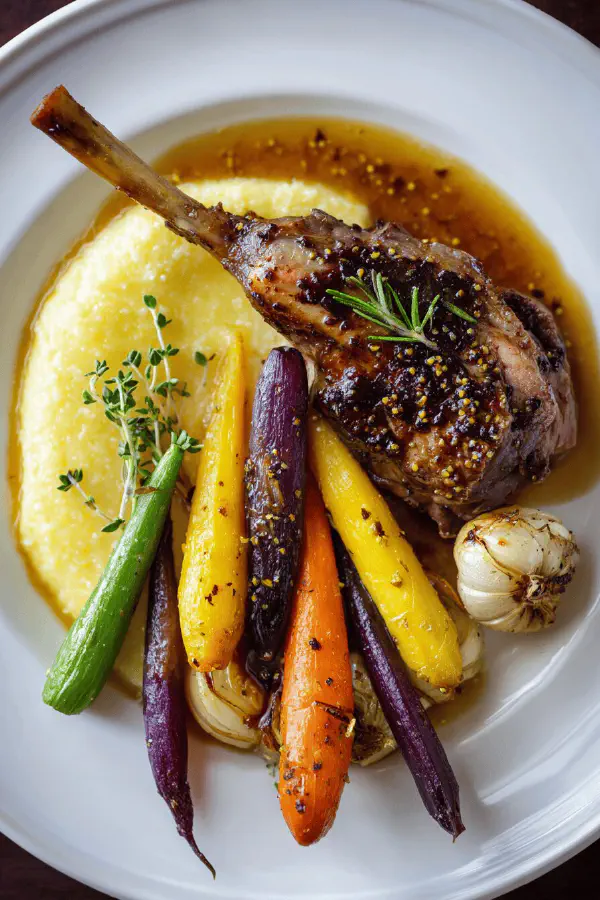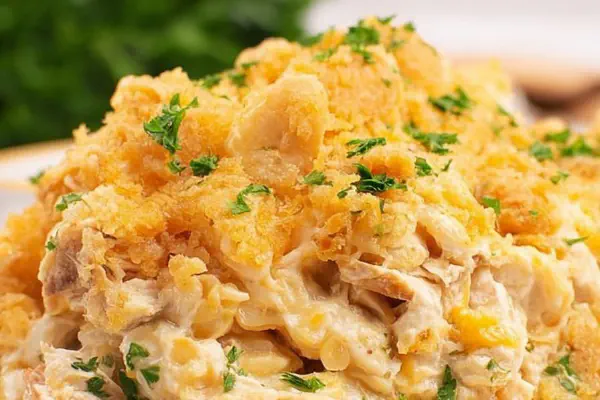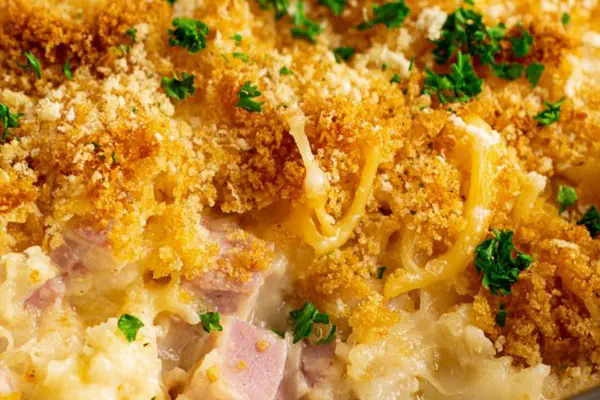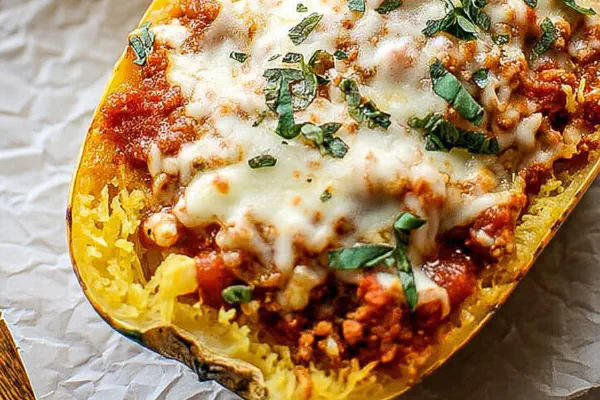Featured Recipe
Roast Lamb Leg with Buckwheat Honey and Golden Carrots

By Kate
"
Roasted lamb leg, glazed with buckwheat honey and balsamic, slow-cooked till just rare then rested to medium. Served on carrots and whole garlic cloves, with a honey-enriched chicken stock sauce thickened with roux. Substituted yellow carrots with heirloom multicolored for flavor depth. Added a touch of smoked paprika for subtle warmth. Carrots and garlic caramelize beneath meat, infusing layers. Sauce balanced sweet, savory, and tangy, with reduction key. Timing flexible, rely on visual and tactile cues. Resting crucial to keep juices intact. A side of creamy parm polenta recommended.
"
Prep:
25 min
Cook:
Total:
Serves:
6 to 8 servings
lamb
roast
dinner
seasonal
comfort food
Introduction
Lamb leg. Big flavor project, but don’t let size scare you. A slow roast with careful glazing ensures the crust locks flavor while interior stays silky rare then gently reaches medium in rest. Carrots and whole garlic below soak up jus, get sweeter, tender, and caramelized, no extra sugar needed. Honey of buckwheat keeps things deep and earthy, replace with wildflower honey if needed but expect lighter flavor. Balsamic adds acid to round the rich meat. Sauce thickened with classic roux, honey lends brightness and luxurious mouthfeel. This isn’t fancy cooking; it’s patience, timing, and trusty basics working together. Skip measuring obsessively. Focus on sight, touch, and smell. Dark brown crust on meat, softness in veggies, fragrances filling the kitchen — those are cues you want. Resting is non-negotiable for juicy slices. Simple but gets you there.
Ingredients
About the ingredients
Carrots—picked multicolored for a subtle earthiness and visual pop over plain yellow. Have extras; they shrink more than you think. Garlic served whole keeps mellow, softens with roasting, no prep needed. Rosemary and bay leaf easy to swap for thyme or sage if unavailable. Buckwheat honey has a strong, bittersweet note that plays beautifully against lamb’s richness. If you only have clover honey, add a pinch of blackstrap molasses or maple syrup for depth. Balsamic vinegar gives acidity and slight sweetness; use a good-quality aged version. Lamb—partial boning easy to handle, but a tied whole works too; temp is king. Chicken broth for liquid keeps pan wet and flavorful. Butter for sauce can be swapped for olive oil to keep dairy away. Smoked paprika boosts warmth—omit if you want traditional flavor, add a pinch of cayenne instead for heat. Keep salt and pepper ready, seasoning made in layers not one pass.
Method
Roast Lamb Leg
- Set oven rack mid-level. Preheat oven to 175°C. Use convection if available to promote even browning. Toss carrots, garlic, rosemary, bay leaves with half olive oil (30 ml) in roasting pan. Season liberally with salt and pepper. Keeps moisture in veggies while roasting.
- In small bowl, whisk buckwheat honey (15 ml) and balsamic vinegar. Set aside.
- Heat remaining olive oil in large skillet over medium-high. Dry lamb well with paper towels; moisture inhibits browning. Season meat with salt and pepper. Sear all sides until deep golden crust develops, 6–8 minutes. Browning locks flavor and juices.
- Transfer lamb onto bed of veggies. Pour chicken broth around—avoid rinsing honey off top of meat. Brush honey-balsamic mix generously over lamb now, then every 20 minutes during roasting.
- Roast 1 hour 15 minutes or until center hits 52°C (125°F) using instant-read thermometer inserted avoiding bone. Slight wobble indicative of rare, preserves tenderness. If unsure, check visually for well-risen juices, very light pink inside. Cover loosely with foil off heat and let rest 20 minutes. Temp will rise to about 58°C (136°F), medium rare. Resting crucial to redistribute juices, avoid dryness.
- While lamb cooks, sweat shallots in butter over medium heat till fragrant and translucent but not brown, about 3 minutes. Season lightly.
- Add flour, stir continuously for 1 minute to form roux; removes raw flour flavor.
- Slowly whisk in chicken broth until smooth. Add remaining buckwheat honey (50 ml) and smoked paprika. Bring to gentle boil, then reduce heat and simmer until sauce thickens to light syrup consistency, around 12-15 minutes. Stir often to avoid lumps and burning, scrape edges.
- Taste, adjust salt and pepper, maybe a tiny dash more vinegar if needed to balance sweetness.
- Slice lamb against grain into thick medallions. Arrange on platter with roasted carrots and tendered garlic.
- Ladle warm sauce over slices, letting it pool around carrots. Serve immediately.
- Polenta enriched with mascarpone and garlic pairs well to cut richness, but simple crusty bread works.
- Enjoy textures—caramelized garlic soft and sweet; lamb crust crisp, interior moist and yielding; sauce silky with punch of flowers from honey and warmth from paprika.
- Look for visual signs over strict timing—carrots wilt, edges slightly browned; lamb juices run faint pink; sauce thickens like honey drizzle on spoon.
Sauce
To Serve
Technique Tips
Brown the lamb well—don’t rush this step. It builds flavor and textures. Searing over medium-high heat till crust forms traps juices inside. Pay attention to aroma change and sizzling sounds for doneness. During roasting, brush honey vinegar mixture three times total for that sticky, shiny coat. Use instant-read thermometer late in cooking; temps are guides but also watch meat firmness and color. Resting covered loosely crucial, it lets muscle fibers relax and redistribute moisture. Sauce relies on proper roux–flour and butter cooked together until bubbling and scent slightly nutty, ensuring no raw flour taste. Add liquid slow to avoid lumps, whisk constantly. Simmer and reduce to syrup consistency; visual test, drizzle over back of spoon, shouldn’t run off quickly. Adjust seasoning at end; get sweet, sour, and saltiness balanced. Serve slices cut against grain to maximize tenderness, pile veggies and drizzle sauce generously. If sauce thickens too much, thin with bit of broth or water. If too thin, simmer longer or add a touch more flour slurry.
Chef's Notes
- 💡 Sear lamb well. Don’t skip this step. Builds crust, adds flavor. Deep golden brown. Listen for the sizzle. Aroma changes, hints at doneness.
- 💡 Use multicolored carrots if available. Adds depth. Don’t worry about exact lengths. Wider pieces caramelize better underneath lamb, sweetness intensifies.
- 💡 Check for doneness visually. Juices should run faintly pink, slight wobble when prodding. Looks matter more than timer. 52°C for rare, better temp guide.
- 💡 Adjust sauce thickness as needed. Too thick, thin with broth. Too runny? Simmer longer, add a flour slurry. Balance is key to sauce.
- 💡 Resting is crucial. Let lamb sit covered loosely. 20 minutes helps moisture redistribute. Temperature rises slightly, keeps meat juicy.
Kitchen Wisdom
How to thaw frozen lamb?
Plan ahead. Fridge overnight works well. Need it faster? Cold water method. Change water every 30 minutes.
What if I don't have buckwheat honey?
Use light wildflower honey instead. Add bit of maple syrup for more depth. Flavor varies but still good.
What sides pair well?
Polenta is great, creamy, cuts richness. Roasted potatoes also solid choice. Fresh salad can brighten heaviness.
Is leftover lamb good?
Yes, keep in fridge 3-4 days. Reheat gently, covers prevent drying out. Use in sandwiches or salads for variety.



